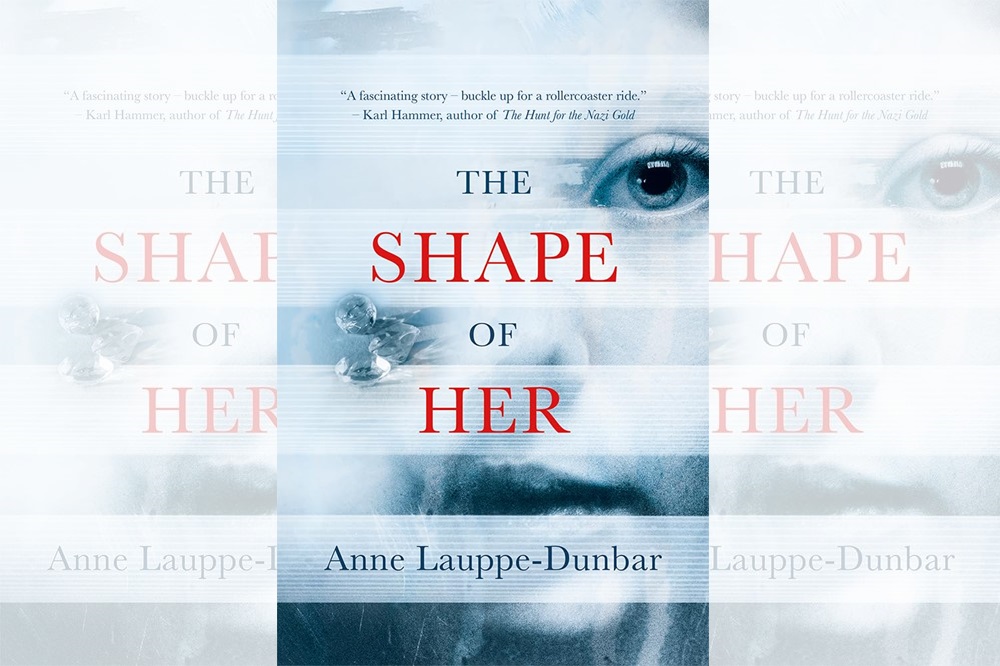Book review: The Shape of Her by Anne Lauppe-Dunbar

Niall Griffiths
There’s a lot of waking up in this book; many chapters and sub-chapters begin with the narrator(s) arising out of sleep, ruminating on half-remembered dreams, shaken and stirred by the subconscious and half reborn into a world half remade.
Indeed, it begins in such a way: ‘it was one of those mornings when the sun crested the gap in the closed blinds and rested a finger on Mum’s lonely Biedermeier desk’. That the sun will rise again is one of the only sureties in this novel.
Confusion
I confess to some confusion in the reading of it; the cast is too large, too diffuse, too undifferentiated and, at times, insubstantially rendered.
A degree of this can be powerful in a novel that has as a central theme the excavation of identity, particularly in an ideologically militarised world (see, for example, Denis Johnson’s Tree of Smoke, which unmoors the reader to a horripilative extent), but the function of a fictional investigation into this notion must surely be to clarify and expiate – to clear, not to thicken, the smog of obfuscation. A more strident editing process would have helped.
Powers
That caveat – large as it is – aside, though, The Shape of Her has its powers. It alternates between Aachen, in the GDR, in 1967, and Groylitz, in 1945, when the Red Army was conquering Germany’s East.
We’re with Katya in 1967 and her mother Ruth in 1945, the extracts from whose diaries are a highlight; stricken and panicked, they recall Viktor Klemperer’s indispensable journals (although his bogeymen wore Jack boots and had lightning bolts and skulls on their lapels).
Ruth was a member of the Wärwolfen (why the various spellings of that noun, incidentally?), a somewhat chaotic grouping of diehard Nazis designed to harry, as a guerilla force, the occupying victorious armies.
Personally, I would’ve liked more discussion and examination of this; the fact that Ruth joined them as a way of escaping punition, and not out of sympathetic ideology, offers the distance that allows appraisal. This seems like a missed opportunity.
Occult roots
There is some stuff about runic clues – again, the chance for a study of Nazism’s occult roots here is largely passed by – and stolen diamonds (ditto the collusion in Nazi plunder by big business and certain ‘neutral’ countries).
Katya, it turns out, is a child of rape, and indeed the presence and power of predatory masculinity is as present in her era as it was in her mother’s. She has been instrumental in the assassination of Aachen’s mayor.
She is kidnapped by statist agents and taken to Hoheneck prison where part of her interrogation is exposure to a song, the Marsch-Impromptu, that her mother allegedly ‘stole’ (the score for which is used as an addendum).
The song might or might not contain references to, and maybe translations of, the runic symbols, which contain instructions to the whereabouts of the diamonds. You see? It’s a tad confusing.
The furniture of the narrative needs a tidying. ‘There were too many connections, I thought. They reached out in a complicated web’. I totally agree, Katya. I’m with you on that.
Concision
The writing at times has a wonderfully quotable concision: ‘remember how Dad said cruelty had an architecture. It could be disguised as a pretty village square, or a misty forest encircled by barbed wire’.
Or this: ‘she’d seen how desperation could carve a person to a brutish shape’. And, too, there are moments of striking lyrical beauty, often concerning nature: ‘fern curled along the pathway like a line of bobbing seahorses’.
The narrative abounds with natural reference; animals and birds and insects bound and scurry and whir and crawl and flutter throughout.
Yet outside the human mess of paranoia and monstrous self-regard, the world goes on; it just continues to be its beautiful self. Those pieces of the book’s furniture are well-placed and studiously used.
Horror
And I’m left with a question: where are the Nazis, and their victims, in this book? The colossal cemetery of the Holocaust? The millions gassed, shot, experimented upon, torn from life?
There are references, such as this from Ruth – ‘there are dead people in the forest. Their shapes cloud round a deep basin. They lean down and stare at arms and legs that grow up through the freshly dug earth’ – and this from Katya’s POV – ‘paper-thin people who stood behind miles of razor-wire, watching and waiting through dark wet eyes’ – and maybe that’s the way to address the horror, incomprehensible as it is – through allusion, evocation, as a diffuse dread knowledge that overshadows everything, that pollutes everything; to look at it square is to inevitably slam against the wall of disbelief.
I’ve read a library of books on the matter and I’m still no closer to understanding it. Indeed, it can be encapsulated in Elie Wiesel’s anecdote of having an icicle smashed out of his dehydrated hands by a Nazi guard who, in response to the anguished cry of ‘why,’ said ‘here, there is no why’.
As Katya says, early on in this novel: ‘Everything came, happened, and then was’. It’s all here, yes, in all of its mayhem. It’s incumbent on the living to tidy it up.
The Shape of Her by Anne Lauppe-Dunbar is published by Seren. It is available from all good bookshops.
Support our Nation today
For the price of a cup of coffee a month you can help us create an independent, not-for-profit, national news service for the people of Wales, by the people of Wales.






